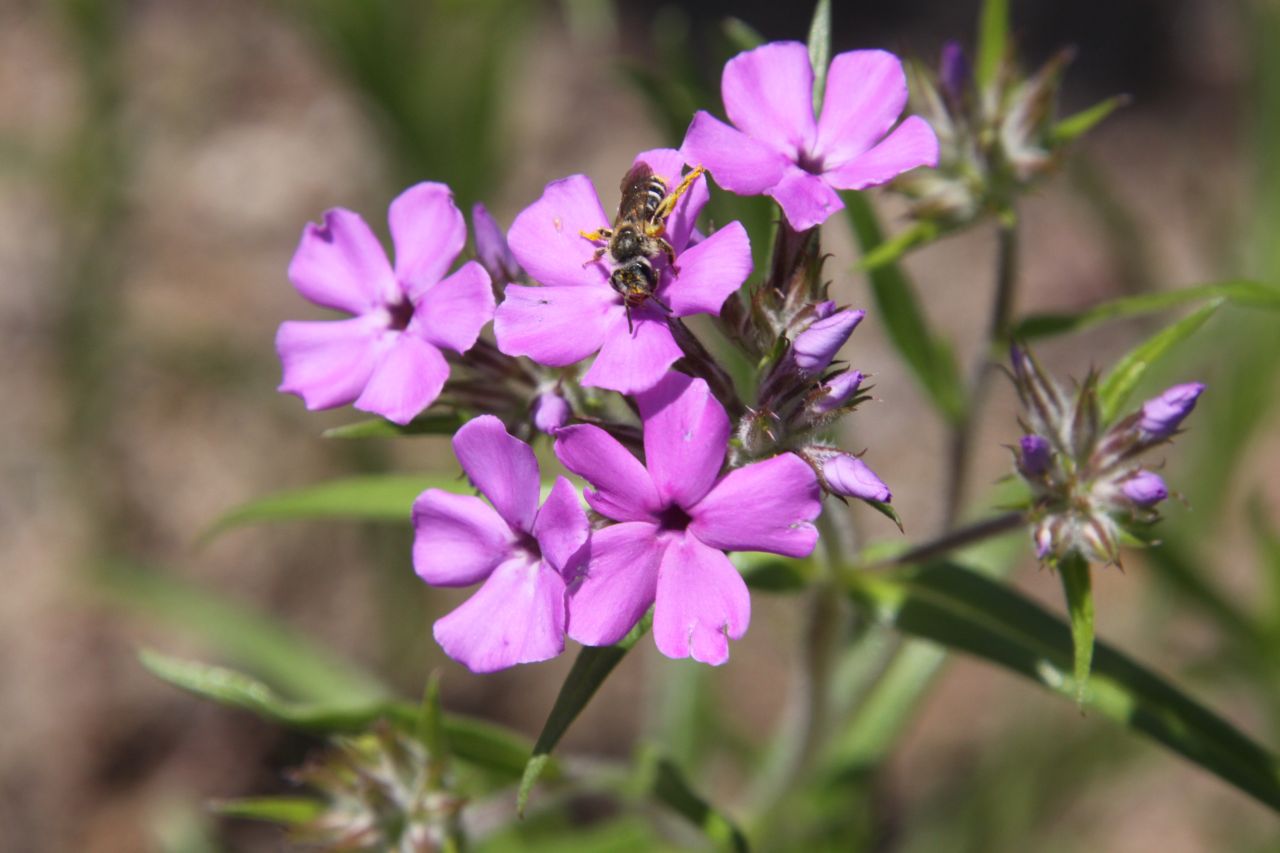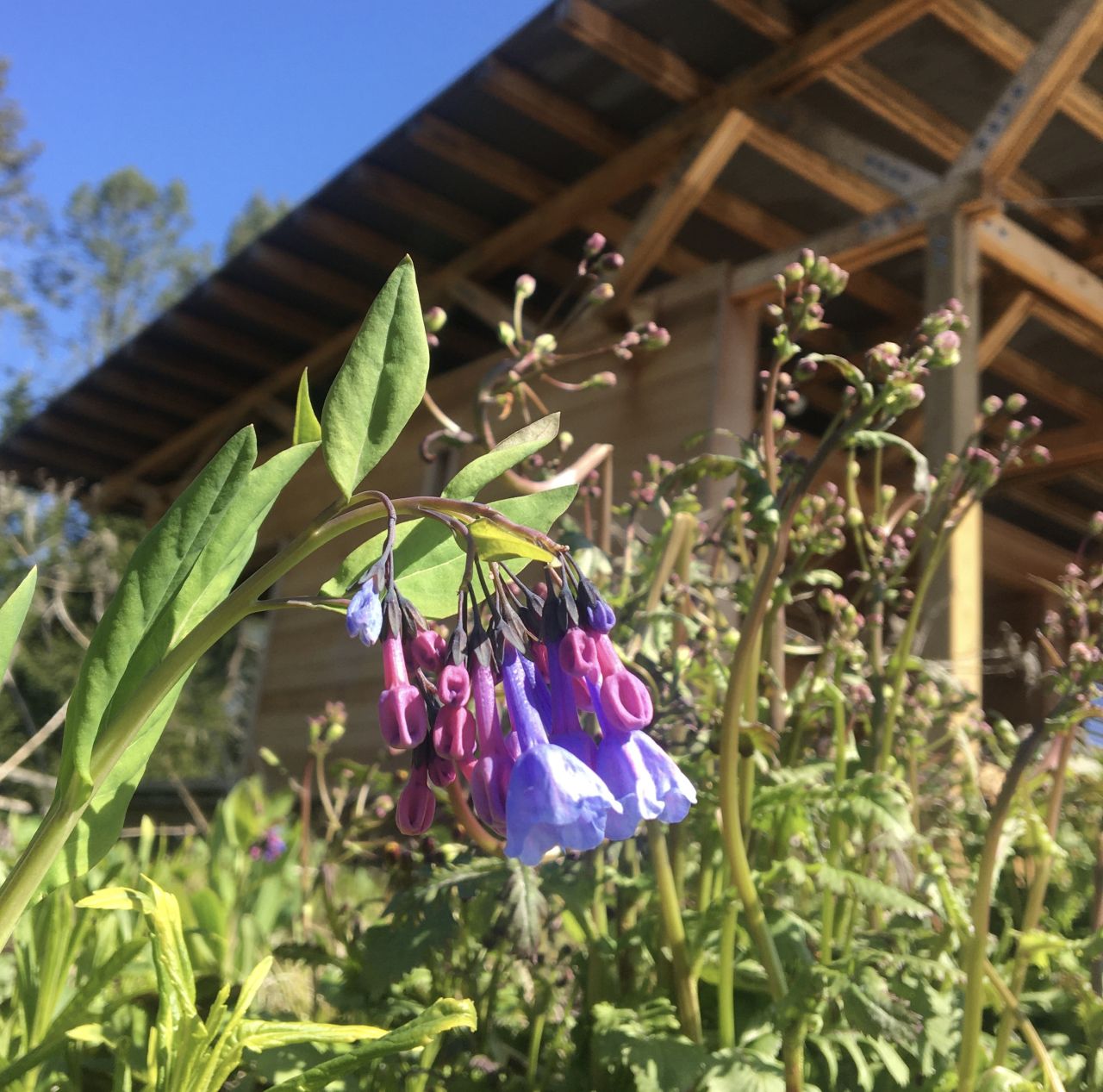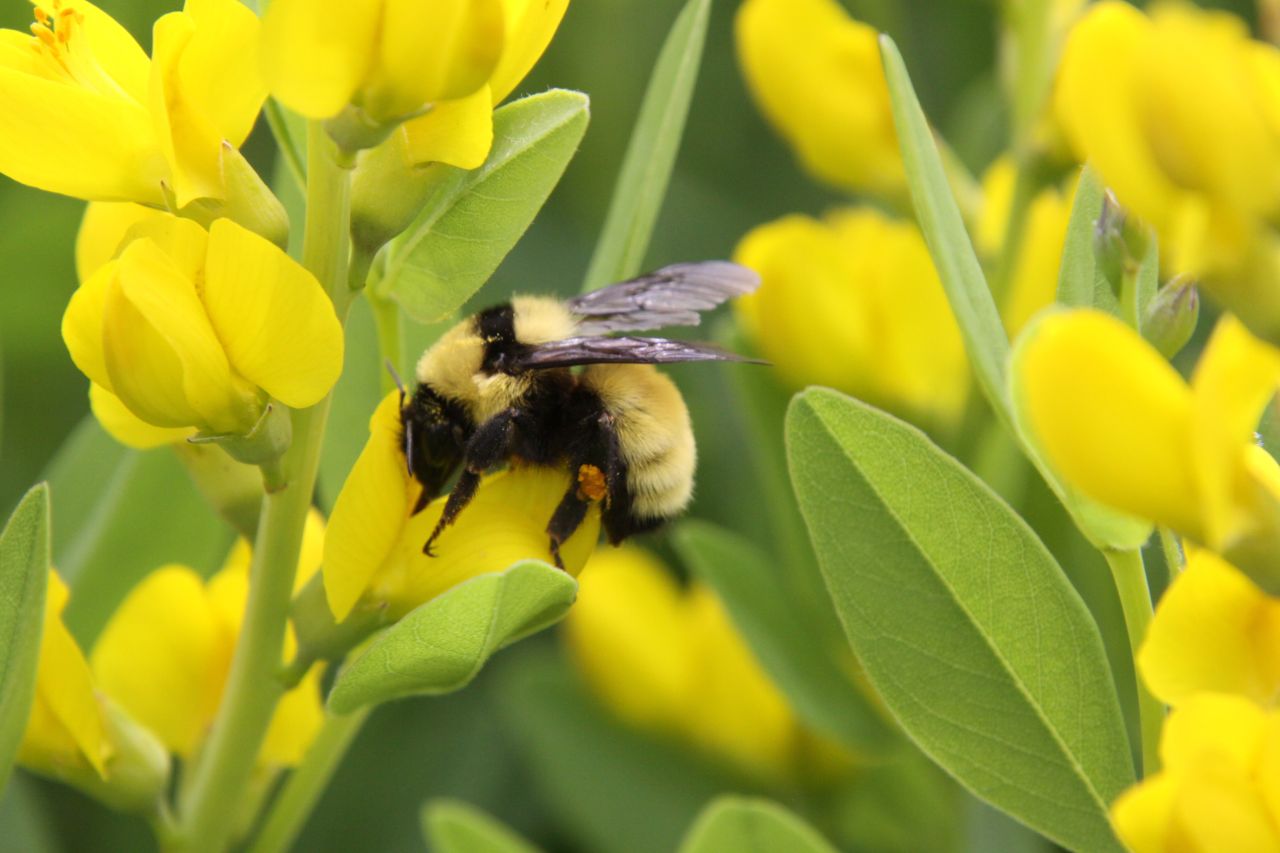May 02, 2024
#PlantMayFlowers
A better way to help pollinators this spring

A bee sits on Downy Phlox (Phlox pilosa) at The Arboretum at Penn State.
Credit: Andy StephensonHarland Patch, Heather Frantz and Christina Grozinger
Center for Pollinator Research, Penn State University
You have probably heard about #NoMowMay, where people stop mowing their lawns in the month of May, to encourage flowers. This was a campaign started in the United Kingdom to “provide a feast for pollinators” among other benefits. While this sounds like a good idea it does not help pollinator populations in North America.
Most lawn flowers in North America are non-native. Quite a number are noxious weeds, like bull thistle, and some like ground ivy are aggressive invasive weeds not just in lawns but also in woodlands. Allowing these weeds to grow can increase their numbers in the landscape and potentially drive down native biodiversity by creating near monocultures.
Some non-native lawn plants are attractive to pollinators, particularly thistle, crown vetch and to a lesser degree, dandelion and white clover. Indeed, this attractiveness helps these invasive plants set seed and spread. But the pollinators you see on these non-native plants are already the most common in the landscape. Adding these plants to a landscape does not improve native pollinator communities or broad biodiversity. In fact, the assemblages found on these plants suggest homogenization where a few common generalist pollinators (in eastern habitats mostly the non-native honey bee (Apis mellifera), common bumblebees like the Eastern bumble bee (Bombus impatiens) and common hover flies go to a few cosmopolitan weed plants. A study in Kentucky found 90% of dandelion visitors in spring to be one bee species (Apis mellifera), one butterfly species (common branded skipper Hesperia comma) and a few hover fly species. Honey bees (Apis mellifera) made up nearly 50% of the pollinators to white clover, with another 30% made up of hover flies, bumble bees make up 10%. (Larson et al 2014).
Common flowering lawn weeds
- Dead Nettle (Lamium purpureum). native to Eurasia
- Ground Ivy (Glechoma hederacea) native to Eurasia
- Black Medic (Medicago lupulina) native to Eurasia, part of Africa
- Broadleaf Plantain (Plantago major) native to Eurasia
- Dandelions (Taraxacum spp.) native to Eurasia
- Bull Thistle (Cirsium vulgare) native to Eurasia and part of Africa
- White Clover (Trifolium repens ) native to Eurasia
- Crown vetch (Securigera varia) native to Eurasia and Africa

Instead of letting non-native plants dominate the spring landscape planting a diversity of native trees, shrubs and flowering forbs (see the list below for a few suggestions) would better support for our native biodiversity.
The reason for this is that our native plants and pollinators form a co-evolved community. The plants have traits that allow for specific interactions, the right kind of nectar and pollen (most bees are pollen specialists), and the right bloom times. These plants are also adapted to their environments. Unlike in Europe where most of our lawn weeds come from, May in eastern North America is tree and shrub season. But with other plants in the understory like Virginia bluebells, columbine, and phlox. Trees and shrubs mass bloom in April and May providing abundant resources for pollinators. It is not really until June that the great majority of open meadow plants begin to bloom.
Researchers at Penn State’s Center for Pollinator Research examined the pollen that wild bees and managed honey bee bees collect to see which plants were providing the most nutritional resources for bees. They found that in April and May, flowering trees provided the most pollen for bees. These include maple, oak, willow, as well as pear (not Callery pear Pyrus calleryana which is classified as a noxious weed), apple and stone fruit trees. From the middle of June and into fall, bees collect pollen from flowering perennials, shrubs and vines.
Another reason to keep grass trimmed is to reduce the risk of tick-borne diseases. Unfortunately, leaving grass unmowed in May or June creates a favorable habitat for ticks and wildlife, including deer, rodents, and birds, which can increase the risk of tick infestations in the area. Maintaining shorter grass provides a drier environment that is unfavorable for ticks and limits the habitat and food sources of wildlife, resulting in reduced tick populations.

Letting weeds grow creates division in communities and has limited value for pollinators. Pollinator gardens bring people together and will truly benefit many species for many years. Pollinators need flowering plants for the entire season from early spring to the first frost. Consider converting your yard into a pollinator haven, adding plants and flower beds over time until you convert your entire lawn into a garden. This garden will beautify your home, improve your well-being and enhance your neighborhood. And it will be a place where pollinators can thrive. Plant May flowers, and flowers for the whole year!
So - what can you do to help the bees in your backyard? See the list below for plants you can include in your garden for May flowers. If you visit the Center for Pollinator Research website there are many resources available to help you select the best plants for supporting bees, butterflies, hummingbirds and other pollinators. This includes guidelines from the Penn State Master Gardeners for creating a Certified Pollinator Garden. For more information on how to protect yourself from ticks, visit Penn State Extension.
The State College Borough is working with the Center for Pollinator Research to include more street trees that support pollinators, and give these trees to homeowners at Arbor Day events. The Borough is also exploring waiving the vegetation height requirement for Certified Pollinator Gardens - so you can have beautiful gardens in your front lawns that are also nutritious for bees.
If you want to learn more about pollinators, build nesting boxes for pollinators, or pick up native plants that attract a diversity of pollinators; there are many events in town that can help!
References
Larson, J.L., Kesheimer, A.J. and Potter, D.A., 2014. Pollinator assemblages on dandelions and white clover in urban and suburban lawns. Journal of Insect Conservation, 18, pp.863-873.
Flowering plants for May/early June:
- Aquilegia canadensis (Eastern Columbine):
Seeds available at Ernst Conservation Seeds.
Plants are available at North Creek Nurseries and New Moon Nursery.
- Baptisia australis (Blue False Indigo):
Seeds available at Ernst Conservation Seeds.
Plants are available at North Creek Nurseries and New Moon Nursery.
- Blephilia ciliata (Downy Pagoda Plant):
Seeds available at Ernst Conservation Seeds.
Plants are available at New Moon Nursery.
- Chrysogonum virginianum (Golden Star or Green and Gold):
Plants available at North Creek Nurseries and New Moon Nursery.
- Coreopsis lanceolata (Lance Leaf Coreopsis):
Seeds available at Ernst Conservation Seeds.
Plants available at New Moon Nursery.
- Coreopsis verticillata (Threadleaf or Whorled Coreopsis):
Plants of ‘Zagreb’ cultivar available at New Moon Nursery.
- Oenothera fruticosa (Sundrops):
Seeds available at Ernst Conservation Seeds.
Plants available North Creek Nurseries and New Moon Nursery.
- Packera aurea (syn. Senecio aurea; Golden Ragwort):
Plants available at North Creek Nurseries and New Moon Nursery
- Penstemon canescens (Eastern Gray Beardtongue):
Seeds available at Ernst Conservation Seeds.
- Penstemon digitalis (Tall White Beardtongue):
Seeds available at Ernst Conservation Seeds.
Plants available at North Creek Nurseries and New Moon Nursery.
- Penstemon hirsutus (Hairy Beardtongue):
Seeds available at Ernst Conservation Seeds.
Plants available at New Moon Nursery.
- Phlox divaricata (Woodland Phlox):
Plants available at North Creek Nurseries and New Moon Nursery.
- Polemonium reptans (Geen Valerian):
Plants available at North Creek Nurseries.
- Salvia lyrata (Lyre Leaf Sage):
Plants of ‘Purple Knockout’ cultivar available at North Creek Nurseries and New Moon Nursery.
- Tiarella cordifolia (Foam Flower):
Plants available at North Creek Nursery and New Moon Nursery
- Tradescantia ohiensis (Ohio Spiderwort):
Seeds available at Ernst Conservation Seeds.
Plants available at North Creek Nurseries and New Moon Nursery.
- Zizia aurea (Golden Alexanders):
Seeds available at Ernst Conservation Seeds.
Plants available at North Creek Nurseries and New Moon Nursery
